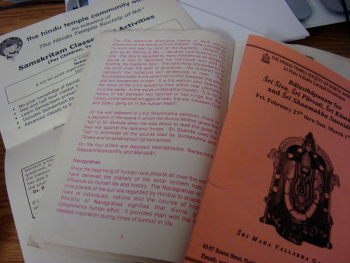From The Peopling of New York City

Personally, I have always felt a little awkward upon entering house of worship that is different from my own (even within the same religion). From my experiences, many of the practices of religion are quite familiar and obvious to the devout, but incredibly confusing and difficult to learn for anyone else. As a result, it is generally quite evident upon observing a religious ceremony as to who is devout and who really has no clue. Aside from my unfamiliarity with Hindu practices, I knew that we would also find it difficult to blend in because most of us are not of South Asian descent. Because of these differences, I accepted the fact that our trip to the Hindu temple would be an experience but would perhaps be awkward and a little embarrassing.
Despite my worrying, I felt none of the awkwardness I had anticipated. Although there were some confused stares, the temple was extremely welcoming and actually clarified many of the questions I had regarding Hinduism as a religion.
Upon entering the temple area, we were told to remove our shoes. Although I was ambivalent to remove my shoes, I was reassured by the plethora of shoe racks, surely no one would steal my shoes. Next, we entered the temple. I was amazed to see all of the altars and statues. Amazingly, as foreign as these objects were to me, there were people walking around the statues and performing rituals. There were elderly people performing customs they had probably performed in India long ago. And completing the circle, there even parents walking around teaching their children about the various customs, trying to instill and sense of responsibility and ancestry on a population that was born and raised in the Indian Diaspora.
It seemed as if a ceremony was taking place, but there were no formal rules nor were people really being quiet. The temple seems easy going as compared to other religious institutions. Additionally, the leaders seemed incredibly welcoming. Perhaps they are aware of the mystery and misconceptions associated with Hinduism. In America, we are so accustomed to strictly monotheistic religions without idolatry, that it is difficult to imagine a religion in which god cannon be defined and worshipers and chose which deity suits them best.
In addition to the friendly man that explained the basics of the holiday, the temple produced a pamphlet that explained the history of the temple and the highlights of the religion. It seems as if the temple tries to be inviting to outsiders. In fact, the last page of the booklet states, “We also welcome those who belong to other faiths. We do invite them to be united with us in prayer.” Although I still have questions regarding the Hindu faith, these temple produced agents clarified things for me.
Perhaps, the most striking aspect of temple and its members was the fact that, aside from the prayer service, English was the language I could discern most. We would expect an immigrant population to converse in their native language, but Indians living in the United States are faced with a problem few immigrant populations know. The subcontinent of India is home to a variety of languages and dialects, some relating very little to others. In India, it is likely that a person would live in an area surrounded by people who speak the same language; yet, the nature of Diaspora tic living, requires South Asians to live, and thus attend temple, with a variety ethnic groups. In order to quell this conundrum, the temple resorts, as does India, to use English as the official language. Nonetheless, the temple offers classes in Hindi, Telugu, Sanskrit, Kannada, and Tamil, in addition to SAT classes and Chemistry Regents review. Clearly, the temple is trying to bring the old world to America while helping American children succeed.
Overall, visiting the temple was an invaluable experience. It will be interesting to see how the Temple balances its attempts to cater to the character of the community while maintaining the taste of traditional India.